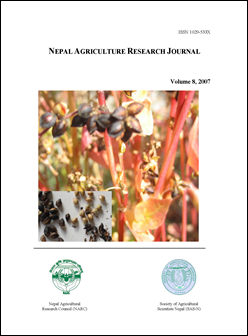Pollen and Spikelet Analysis in F1 Rice Hybrids and their Parents
DOI:
https://doi.org/10.3126/narj.v8i0.11605Keywords:
Correlation, F1 rice, Pollen category, Regression coefficientAbstract
Pollen analysis can be used to discriminate between different species, identify possible interspecies hybrids, identify restorer and maintainer lines, useful to study genetics of restorer gene, interaction between chromosome and cytoplasm and relationship between parents. Pollen abortion system of male sterility is an important tool in hybrid rice production and spikelet is the major yield components. Nine improved cultivars, six landraces and three wild aborted cytoplasmic-genetic male sterile (CMS) lines were used to analyze pollen and spikelet in F1 rice hybrids and their parents. The frequency of pollen categories and its relationship to spikelet fertility were investigated. Pollen sterility of the F1s was determined by staining pollen grains in 1% potassium iodide-iodine (I-KI) solution. Spikelet fertility was determined by counting the total number of seed set in proportion to the total number of spikelets. Correlation and regression coefficients for some traits were computed. In hybrids, pollen fertility ranged from 0.5 to 82% and spikelet fertility from 0 to 87%. Pollen fertility varied from 28 to 97%, while spikelet fertility from 73 to 91% in pollen parents. The highest and the lowest percentages of pollen fertility were found in Chaite-6 and Chiunde cultivars respectively. Spikelet fertility percentage varied widely among hybrids and many hybrids had lower spikelet fertility percentage than their parents. Therefore, it is of practical importance to understand the causes of high spikelet sterility in hybrids for possible increase in spikelet fertility. Highly significant positive correlation was found between stained round fertile (SRF) pollen and spikelet fertility. The positive value of correlation and regression coefficient on SRF and spikelet fertility were found between F1 and mid parent, and F1 and male parent. High fertility of cross may be due to the presence of a wide compatibility gene or restorer genes in the cultivar. Lower pollen and spikelet fertility of the crosses was attributed to effect of the genetic background of the tester parent.
Nepal Agric. Res. J. Vol. 8, 2007, pp. 120-126
Downloads
Downloads
Published
How to Cite
Issue
Section
License
This license allows reusers to copy and distribute the material in any medium or format in unadapted form only, for noncommercial purposes only, and only so long as attribution is given to the creator.




